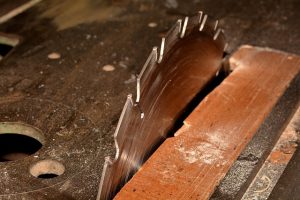What Is A Table Saw
 A table saw is a versatile power tool commonly used in woodworking and construction to make straight cuts in various materials, primarily wood. It consists of a circular saw blade mounted on an arbor, protruding through the surface of a flat table. The blade can be adjusted in height and angle to accommodate different cutting needs. Table saws are powerful and precise tools, but they also require proper safety precautions when in use. Operators should use safety gear, such as safety goggles and hearing protection, and follow safety guidelines to prevent accidents and injuries.
A table saw is a versatile power tool commonly used in woodworking and construction to make straight cuts in various materials, primarily wood. It consists of a circular saw blade mounted on an arbor, protruding through the surface of a flat table. The blade can be adjusted in height and angle to accommodate different cutting needs. Table saws are powerful and precise tools, but they also require proper safety precautions when in use. Operators should use safety gear, such as safety goggles and hearing protection, and follow safety guidelines to prevent accidents and injuries.
Table saws are used for a wide range of cutting tasks, including:
Rip Cuts
A table saw is excellent for making long, straight cuts parallel to the grain of the wood. This is useful for cutting boards to width or creating straight edges on large pieces of wood.
Crosscuts
With the help of a miter gauge or a sled, table saws can also make precise cuts perpendicular to the grain, which is handy for cutting boards to length or making small pieces.
Bevel Cuts
The blade on a table saw can be tilted to make bevel cuts at various angles, allowing for the creation of beveled edges or angled joints.
Dado Cuts
By using dado blade sets, table saws can create wider cuts or grooves to accommodate shelves, joints, or other elements in woodworking projects.
Rabbet Cuts
Table saws can be used to cut rabbets (grooves) along the edge of a workpiece, often used for joining pieces together.
Miter Cuts
By using a miter gauge or miter sled, table saws can make precise angled cuts across the width of the material, enabling the creation of frames and molding.
Taper Cuts
With a tapering jig, table saws can cut material at an angle along its length, resulting in a tapered edge.
Do I Need a Table Saw
Whether or not you need a table saw depends on your specific woodworking or cutting requirements, the scale of your projects, and your personal preferences. Table saws are powerful and versatile tools, but they may not be necessary for every DIY enthusiast or woodworker. Consider the following factors to determine if you need a table saw:
Project Complexity – If you frequently work on woodworking projects that involve making straight cuts, such as cutting large boards, sheets of plywood, or other materials with precision, a table saw can be a valuable addition to your workshop.
Versatility – Table saws can handle a wide range of cutting tasks, including rip cuts, crosscuts, bevel cuts, and more. If you need a tool that can perform multiple types of cuts accurately, a table saw can be an excellent investment.
Workspace and Budget – Table saws can be large and require dedicated workspace. If you have enough space in your workshop or garage and can afford a table saw, it can be a worthwhile purchase. However, if space is limited or your budget is tight, you might consider alternatives like circular saws, jigsaws, or miter saws, which can handle specific types of cuts and may be more affordable.
Safety and Experience – Table saws are powerful tools that demand proper safety precautions and experience to use effectively. If you are inexperienced with power tools or unsure about handling a table saw safely, it might not be the best option for you.
Specific Projects – Consider the specific projects you have in mind. If you mainly plan to work on smaller projects with minimal cutting needs, a table saw might not be necessary.
If you decide that a table saw is not essential for your current needs, you can explore other tools like circular saws, jigsaws, hand saws, or miter saws, which are more portable and might better suit your projects. Remember that safety should always be a priority when working with any power tools, so if you’re unsure about using a table saw, seek guidance from experienced woodworkers or attend woodworking classes to gain more confidence and knowledge.
9 inch Table Saw Blades
The blade size for a table saw is typically determined by the diameter of the blade. A 9-inch table saw blade refers to the diameter of the circular saw blade that fits the table saw with a 9-inch blade capacity and you can find different types of blades designed for various materials and cutting applications. Here are some common types of table saw blades:
- Rip Blades. These blades are designed for cutting along the wood grain, making them ideal for rip cuts.
- Crosscut Blades. These blades are used for cutting across the wood grain, providing smoother and cleaner cuts.
- Combination Blades. These are versatile blades that can handle both rip and crosscutting tasks.
- Dado Blades. Dado blades are specialized blades used for making wider cuts, such as grooves or dadoes.
When selecting a table saw blade, consider the type of material you’ll be cutting (e.g., wood, metal, plastic) and the type of cut you need (rip or crosscut). Also, pay attention to the number of teeth on the blade, as blades with more teeth generally provide smoother cuts.